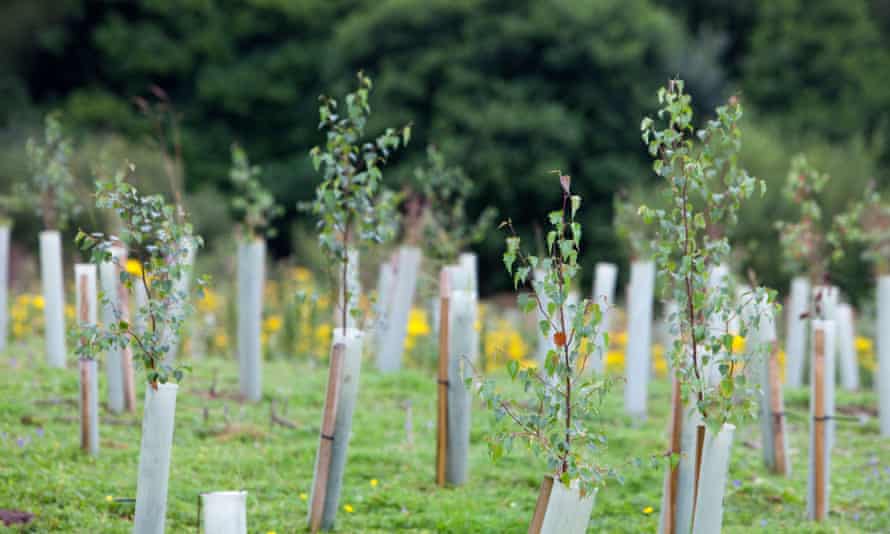Reforestation hopes threaten global food security, Oxfam warns
Over-reliance on tree-planting to offset carbon emissions could push food prices up 80% by 2050

Governments and businesses hoping to plant trees and restore forests in order to reach net-zero emissions must sharply limit such efforts to avoid driving up food prices in the developing world, the charity Oxfam has warned.
Planting trees has been mooted as one of the key ways of tackling the climate crisis, but the amount of land needed for such forests would be vast, and planting even a fraction of the area needed to offset global greenhouse gas emissions would encroach on the land needed for crops to feed a growing population, according to a report entitled Tightening the net: Net zero climate targets implications for land and food equity.
At least 1.6bn hectares – an area five times the size of India, equivalent to all the land now farmed on the planet – would be required to reach net zero for the planet by 2050 via tree-planting alone. While no one is suggesting planting trees to that extent, the report’s authors said it gave an idea of the scale of planting required, and how limited offsetting should be if food price rises are to be avoided.
Nafkote Dabi, climate policy lead at Oxfam and co-author of the report, explained: “It is difficult to tell how much land would be required, as governments have not been transparent about how they plan to meet their net-zero commitments. But many countries and companies are talking about afforestation and reforestation, and the first question is: where is this land going to come from?”
Food prices could rise by 80% by 2050, according to some estimates, if offsetting emissions through forestry is over-used. About 350m hectares of land – an area roughly the size of India – could be used for offsetting without disrupting agriculture around the world, but taken together the plans for offsetting from countries and companies around the world could soon exceed this.
Dabi said: “Already, hundreds of millions of people around the world are going hungry. We need to consult countries on how they are going to use their land, and countries and companies need to reduce their emissions first [before relying on offsetting]. We also need to reduce emissions from agriculture, which is the second biggest source of emissions globally.”
The report also found that two of the most commonly used offsetting measures, reforestation and the planting of new forests, were among the worst at putting food security at risk. Far better, according to the analysis, were nature-based solutions that focused on forest management, agroforestry – the practice of combining crop cultivation or pasture with growing trees – as well as pasture management and soil management in croplands. These would allow people to use the land for food while sequestering carbon.
Dabi explained: “We are not against afforestation and reforestation, and we do not want to stop people doing these things. But they should not be used at a large scale and should be combined with other methods such as agroforestry.”
She gave the example of Switzerland, which is planning to offset about 12.5% of its emissions through carbon credits from projects in other countries, including Peru and Ghana. To reach that target would take an area the size of Costa Rica, Oxfam estimated.
Some companies are also planning to use carbon offsetting based on trees and land as part of their efforts to reach net-zero emissions. Oxfam found that many of these plans, taken together, could amount to an over-use of land.
For instance, four leading energy companies would require an area twice the size of the UK for their offsetting. Shell would need about 28.6m hectares by 2050, according to Oxfam’s estimates, while TotalEnergies plans to offset about 7% of its emissions, needing about 2.6m hectares by 2050. Eni, another energy company, has plans for 8m hectares of forestry, but Oxfam calculates that double this could be needed. BP has not set out its plans in detail, but is likely to require as much as 22.5m hectares for offsetting as much as 15% of its emissions, Oxfam estimated.
Danny Sriskandarajah, chief executive of Oxfam GB, called for companies and governments to cut their emissions drastically rather than relying on offsets. He said: “Too many companies and governments are hiding behind the smokescreen of ‘net zero’ to continue dirty business-as-usual activities. A prime example of the doublethink we are seeing is the oil and gas sector trying to justify its ongoing extraction of fossil fuels by promising unrealistic carbon removal schemes that require ludicrous amounts of land.”
He added: “Net-zero targets are vital to tackling climate change. Some governments and companies are taking bold action to cut emissions but there are currently too few to give us a realistic chance of averting climate catastrophe and the widespread hunger and devastation that come with it.”
A spokesperson for BP said: “BP does not intend to rely on offsets to meet either our 2025 emissions reduction targets or 2030 aims. However, they may help us to go beyond those aims if we can. We do support the use of carbon offsets or credits by companies, countries and society to achieve faster and lower cost pathways to net-zero and help meet the Paris goals.”
Shell said it did not recognise Oxfam’s estimates. “Meeting a net-zero target requires fundamentally changing the forms of energy Shell supplies and then using offsets at the margin to compensate for any remaining emissions, ie we are changing the products that we sell,” said a spokesperson.
“As Shell shifts its portfolio to more and more renewable and low-carbon sources of energy, it could well be that the emissions associated with energy sold by Shell in 2050 is less than the quantity of carbon credits we expect to be able to supply our customers in 2030.”